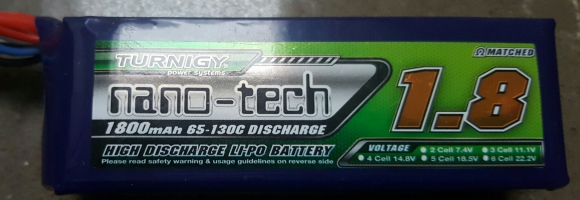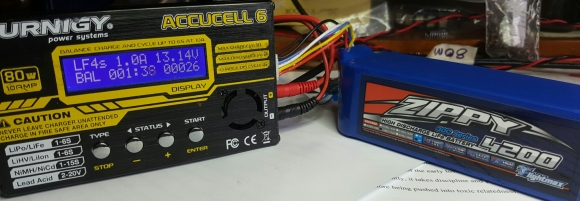When the time came recently for a new battery, I jumped onto HobbyKing and was bewildered by the range of options, even after limiting the search to a particular current capacity, in my case 4-5AH, and 4S (4 cells). Wishing to leverage the ‘wisdom of the SOTA crowd’, and at risk of reopening the “whats the best battery for SOTA” chestnut, I posted to the yahoo SOTA_Australia group:
I’m buying another LiPo from HobbyKing. This battery will be for general purpose 5 watt txcvr use, but will also be used to power an afterburner of the W6JL type, using a pair of IRF2Z24N hexFETs, for up to 50 watts. My question is, what do I make of the discharge figure on the LiPo packs, which varies from 10c to 35c? I presume this is the rate at which the battery can supply current under load, the higher the better. A higher discharge figure might be important when powering an afterburner, which might draw current peaks of many amps on voice peaks. Prices seem to correspond with higher discharge figures, from as low as $25 (10c) up to $55 (35c) for packs around the 4AH rating.

My only current Li-XXX asset.
The SOTA crowd responded, in fine form, as expected. From David, VK3IL:
The C rating relates to the maximum discharge current you can draw safely. So with a 25C battery of 4Ah capacity, you can safely draw 25 x 4 = 100A! These batteries are aimed at RC models which use very high current DC motors, somewhat different from our needs. Even the lowest 10C rated battery is going to be plenty for driving most of our gear.
One thing to consider though is LiPO vs LiFePO4. The amp you are looking at feeds the transistors directly off the battery, so the power output will be roughly proportional to the battery voltage. A 3S LiPO has a nominal voltage of 11.1V with a range from about 12.6V down to 9V absolute minimum. The amp will be looking for 13.8V for rated power output. A 4S LiFePO4 has a voltage ranging from 14.6V to about 11V. This is likely to give you a better power output from the amp I think. LiFePO4 are also safer and supposedly have a longer cycle life.
I’m looking at a 4S pack, for the extra volts. All my SOTA rigs are homebrew, the small signal modules are all 3-pin regulated, and the finals (all IRF510s at this time) love a bit of extra juice on their drains. From Matt VK1MA:
Dave’s comments are spot on – and particularly agree with the LiFePO4 comments, I have three of the 4S2P 8400mAh LiFePO4 batteries and rate them highly. I find that I can get around a 90 minute activation per battery at 60-80W.
Although more expensive, the better voltage range of the 4S batteries means that they are better suited to the higher power radios (or a QRP radio with an amp) than the LiPo batteries and you do not need to worry about dropping the voltage to prevent damage (fully charged a 4S LiPo is 16.8V versus 14.4V).
A little more than I had expected to invest on this occasion, but wow! 8.4AH! All from a pack weighing in at under a kilogram. This is overkill for my 5 watt rigs, but ideal for the day when I run more power. Not for every summit, though.
Andrew VK1AD reminded us of his post on batteries, which confirms for me that the LiFePOs at 4.2 and 8.4AH are the activator’s preferred choice.
Peter VK3ZPF fitted an inline fuse holder to his 8400mAh LiFePO4 batteries. That’s a basic piece of tribal knowledge that I have overlooked with my batteries to date.
Ron VK3AFW laid out his battery selection logic with the precision of a methodologist:
Here’s how I now choose my batteries:
Do I want a specific minimum voltage? Yes, 11 V for 817, 12.3 V for other.
Do I have a maximum voltage I can accept? Yes 16 V unless I carry a converter.The LiPo is lighter and cheaper but it’s discharge voltage covers quite a range. For simplicity and less things to forget to bring I’m mainly using LiFePo4 because of their stable discharge voltage and lower weight cf lead acid. They are less prone to trouble than LiPo. So 4S LiFePo4.
Capacity? Lets say I want an operational time of 1 hour. I’ll assume I listen for 50% of the time. If Rx consumes say 300 mA average. Need 0.15 Ah. If the tx has an average consumption of 1 A and 2 A max then I need 0.5 + 0.15 = 0.65 Ah. Peak current is just over 3 C. Assume PA is used with 12 A peak, 9 A average with compressor on, 50% of time. Need 4.5 AH. So next capacity above 4.8 AH is suitable. Peak current is less than 3 C.
If I were to select something like 1 Ah for the first case and 6 AH for the second then I would have some reserve for loss of capacity as the battery ages. Peak current is less than 5C in both cases. High discharge versions not required. Purchase to be based on availability and reliability vs price.
So I learned a few important things… the difference LiPo and LiFePO4 battery technologies (significantly that LiFePO4s seem to discharge more predictably, fully charged voltage is 13.2v rather than 16.8v, they are ‘a longer-life chemistry’), and that the discharge rating (‘C’ value) is not material for our purposes.
The thread rolled on to cover the recent emergence of LiFePO4 (also called LFP) batteries for the electric vehicle market, and the feasibility of using two or three mobile phone recharge battery packs in series (an 817 should run OK on two basic 2.2 Ah chargers in series for well over an hour… other small rigs would be OK on 3 in series if designed for 13.8 V +/- 10%). A real benefit of this power scheme is that these packs attract little if any attention at airport check in. The thread ended up discussing gas-powered cells (thanks Compton VK2HRX). From the sublime to the ridiculous?
So, at the end of it all, I’ve ordered a Zippy Flightmax LiFePO4 4S2P pack. I’ll put the 8.2AH pack on my HobbyKing wishlist. I don’t have a rig that needs that capacity yet.
More power to me.
Thanks to all who contributed to this thread on yahoo SOTA_Australia.
Postscript 2 Feb 2017: Here it is on the balance charger…


Paul, Another solution that interests me greatly for QRP power is a hand portable fuel cell that is being developed via Kickstarter. It’s not due until Dec this year, but if it materialises could be very good for multi-day hike activations – just need a boost converter battery charger (which is on my todo list). Here’s a link: http://hellokraftwerk.com/
73
David
LikeLike
Hi David, on the ‘kraftwerk’ power source, firstly, I hope the iconic German electronica ‘robot pop’ band sues the pants off them for shamelessly stealing their name. Secondly, where on the site can you find any description of what it is? 8^) vk3hn.
LikeLike
Hi Paul, the gas fuel cells are intriguing! Note that the Kickstarter page promises delivery by early 2016 – sounds like they missed that deadline. In the meantime, LiFePO4 is a cost effective technology. I believe the car manufacturers use hundreds of small steel encapsulated cells in banks – these 18650 cells are available to amateurs but would weigh and cost more than the plastic packaged cells designed for model aircraft. Thanks for the informative article on how you arrived at your choice of power pack!
73 David VK3KR
LikeLike